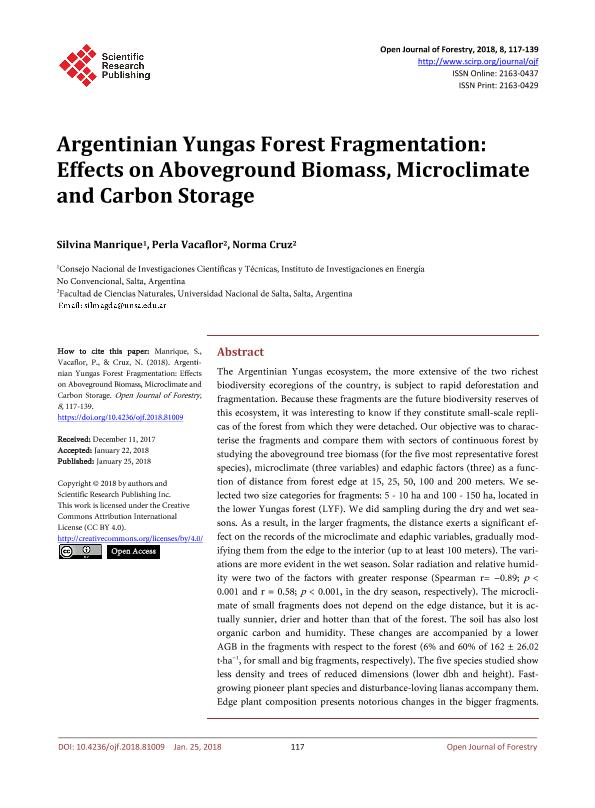Mostrar el registro sencillo del ítem
dc.contributor.author
Manrique, Silvina Magdalena

dc.contributor.author
Vacaflor, Perla
dc.contributor.author
Cruz, Norma
dc.date.available
2018-12-11T15:21:13Z
dc.date.issued
2018-01-25
dc.identifier.citation
Manrique, Silvina Magdalena; Vacaflor, Perla; Cruz, Norma; Argentinian Yungas Forest Fragmentation: Effects on Aboveground Biomass, Microclimate and Carbon Storage; Scientific Research Publishing; Open Journal of Forestry; 08; 01; 25-1-2018; 117-139
dc.identifier.issn
2163-0429
dc.identifier.uri
http://hdl.handle.net/11336/66248
dc.description.abstract
The Argentinian Yungas ecosystem, the more extensive of the two richest biodiversity ecoregions of the country, is subject to rapid deforestation and fragmentation. Because these fragments are the future biodiversity reserves of this ecosystem, it was interesting to know if they constitute small-scale repli- cas of the forest from which they were detached. Our objective was to charac- terise the fragments and compare them with sectors of continuous forest by studying the aboveground tree biomass (for the five most representative forest species), microclimate (three variables) and edaphic factors (three) as a func- tion of distance from forest edge at 15, 25, 50, 100 and 200 meters. We se- lected two size categories for fragments: 5 - 10 ha and 100 - 150 ha, located in the lower Yungas forest (LYF). We did sampling during the dry and wet sea- sons. As a result, in the larger fragments, the distance exerts a significant ef- fect on the records of the microclimate and edaphic variables, gradually mod- ifying them from the edge to the interior (up to at least 100 meters). The vari- ations are more evident in the wet season. Solar radiation and relative humid- ity were two of the factors with greater response (Spearman r= −0.89; p < 0.001 and r = 0.58; p < 0.001, in the dry season, respectively). The microcli- mate of small fragments does not depend on the edge distance, but it is ac- tually sunnier, drier and hotter than that of the forest. The soil has also lost organic carbon and humidity. These changes are accompanied by a lower AGB in the fragments with respect to the forest (6% and 60% of 162 ± 26.02 t∙ha−1, for small and big fragments, respectively). The five species studied show less density and trees of reduced dimensions (lower dbh and height). Fast- growing pioneer plant species and disturbance-loving lianas accompany them. Edge plant composition presents notorious changes in the bigger fragments. Biomass and ecosystem processes such as carbon cycling, which have been modified into fragments, both are directly associated with the structure and functioning in LYF remnants. The human and animal intervention detected in the area could be interacting synergistically with the microclimate and bio- logical changes observed and potentiate the effects of degradation in the frag- ments, creating conditions of greater threat to LYF?s biodiversity. However, the management of the LYF ecosystem within an adequate land use scheme could conserve and even encourage the recovery of the fragments ensuring a natural legacy of great importance for the country. Financing opportunities and globally assumed responsibilities in the context of climate change could consti- tute a favorable framework for the implementation of strategies to safeguard these forests.
dc.format
application/pdf
dc.language.iso
eng
dc.publisher
Scientific Research Publishing
dc.rights
info:eu-repo/semantics/openAccess
dc.rights.uri
https://creativecommons.org/licenses/by-nc-sa/2.5/ar/
dc.subject
Biogeochemical Carbon Cycle
dc.subject
Biomass
dc.subject
Carbon Sequestration
dc.subject
Edge Effects
dc.subject
Microclimate Changes
dc.subject.classification
Meteorología y Ciencias Atmosféricas

dc.subject.classification
Ciencias de la Tierra y relacionadas con el Medio Ambiente

dc.subject.classification
CIENCIAS NATURALES Y EXACTAS

dc.title
Argentinian Yungas Forest Fragmentation: Effects on Aboveground Biomass, Microclimate and Carbon Storage
dc.type
info:eu-repo/semantics/article
dc.type
info:ar-repo/semantics/artículo
dc.type
info:eu-repo/semantics/publishedVersion
dc.date.updated
2018-10-23T17:31:27Z
dc.identifier.eissn
2163-0437
dc.journal.volume
08
dc.journal.number
01
dc.journal.pagination
117-139
dc.journal.pais
China

dc.journal.ciudad
Hubei
dc.description.fil
Fil: Manrique, Silvina Magdalena. Consejo Nacional de Investigaciones Científicas y Técnicas. Centro Científico Tecnológico Conicet - Salta. Instituto de Investigaciones en Energía no Convencional. Universidad Nacional de Salta. Facultad de Ciencias Exactas. Departamento de Física. Instituto de Investigaciones en Energía no Convencional; Argentina
dc.description.fil
Fil: Vacaflor, Perla. Universidad Nacional de Salta. Facultad de Ciencias Naturales; Argentina
dc.description.fil
Fil: Cruz, Norma. Universidad Nacional de Salta. Facultad de Ciencias Naturales; Argentina
dc.journal.title
Open Journal of Forestry
dc.relation.alternativeid
info:eu-repo/semantics/altIdentifier/doi/https://dx.doi.org/10.4236/ojf.2018.81009
dc.relation.alternativeid
info:eu-repo/semantics/altIdentifier/url/https://file.scirp.org/Html/9-1620471_81979.htm
Archivos asociados
